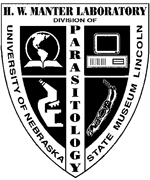Parasitology, Harold W. Manter Laboratory of

Harold W. Manter Laboratory of Parasitology: Library Materials
ORCID IDs
Escalante 0000-0002-1532-3430
Document Type
Article
Date of this Version
8-23-2022
Citation
PLoS One 17(8): e0268161
doi: 10.1371/journal.pone.0268161
Abstract
Great-tailed Grackles (Quiscalus mexicanus) are a social, polygamous bird species whose populations have rapidly expanded their geographic range across North America over the past century. Before 1865, Great-tailed Grackles were only documented in Central America, Mexico, and southern Texas in the USA. Given the rapid northern expansion of this species, it is relevant to study its role in the dynamics of avian blood parasites. Here, 87 Great-tailed grackles in Arizona (a population in the new center of the range) were screened for haemosporidian parasites using microscopy and PCR targeting the parasite mitochondrial cytochrome b gene. Individuals were caught in the wild from January 2018 until February 2020. Haemosporidian parasite prevalence was 62.1% (54/87). A high Plasmodium prevalence was found (60.9%, 53/87), and one grackle was infected with Haemoproteus (Parahaemoproteus) sp. (lineage SIAMEX01). Twenty-one grackles were infected with P. cathemerium, sixteen with P. homopolare, four with P. relictum (strain GRW04), and eleven with three different genetic lineages of Plasmodium spp. that have not been characterized to species level (MOLATE01, PHPAT01, and ZEMAC01). Gametocytes were observed in birds infected with three different Plasmodium lineages, revealing that grackles are competent hosts for some parasite species. This study also suggests that grackles are highly susceptible and develop chronic infections consistent with parasite tolerance, making them competent to transmit some generalist haemosporidian lineages. It can be hypothesized that, as the Great-tailed Grackle expands its geographic range, it may affect local bird communities by increasing the transmission of local parasites but not introducing new species into the parasite species pool.
Included in
Biodiversity Commons, Ornithology Commons, Parasitology Commons


Comments
Open access
License: CC BY